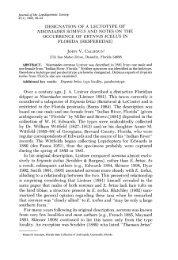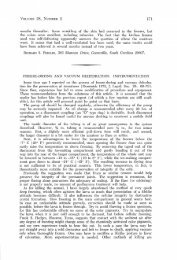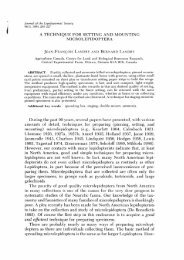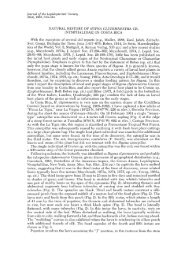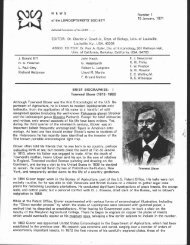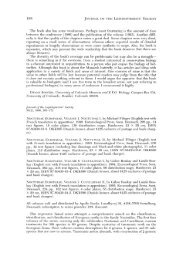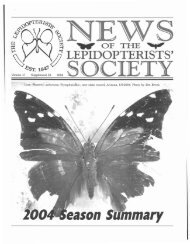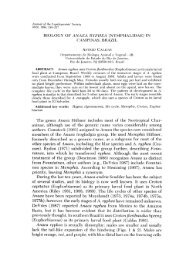Notes on the life cycle and natural history of butterflies of El Salvador ...
Notes on the life cycle and natural history of butterflies of El Salvador ...
Notes on the life cycle and natural history of butterflies of El Salvador ...
Create successful ePaper yourself
Turn your PDF publications into a flip-book with our unique Google optimized e-Paper software.
312 JOURNAL OF THE LEPIDOPTERISTS' SOCIETY<br />
sexual activity, we must assume that members <strong>of</strong> this subfamily are very<br />
secretive about <strong>the</strong>se behaviors.<br />
Females dissected three days after emergence, have no eggs in <strong>the</strong>ir<br />
abdomen. It is not unusual to collect eggs that never hatch, <strong>and</strong> at times<br />
some eggs produce tiny wasps (Chalcidoidea). Quite <strong>of</strong>ten larvae <strong>of</strong><br />
this species are affected by a sort <strong>of</strong> diarrhea that kills <strong>the</strong>m, or by a<br />
disease that s<strong>of</strong>tens <strong>the</strong>ir body tissues until <strong>the</strong>y burst.<br />
DISCUSSION<br />
Comstock (1961) implies that nothing has been published up to now<br />
relating to <strong>the</strong> <strong>life</strong> <strong>cycle</strong> <strong>and</strong> behavior <strong>of</strong> <strong>the</strong> early stages <strong>of</strong> Anaea<br />
(Memphis) eurypyle c<strong>on</strong>fusa.<br />
As expected, <strong>the</strong> eggs <strong>of</strong> this species resemble very closely in shape<br />
all <strong>the</strong> eggs <strong>of</strong> <strong>the</strong> species <strong>of</strong> Charaxinae we have been able to rear, even<br />
to <strong>the</strong> color (with <strong>the</strong> excepti<strong>on</strong> <strong>of</strong> A. (Zaretis) itys whose color is<br />
transluscent yellow, instead <strong>of</strong> transluscent greenish-white). Fur<strong>the</strong>rmore,<br />
<strong>the</strong> shape <strong>and</strong> habits <strong>of</strong> <strong>the</strong> larvae are very similar to those <strong>of</strong><br />
A. (C.) fabius, A. (C.) electra <strong>and</strong> A. (Memphis) pithyusa R. Felder;<br />
<strong>and</strong> <strong>the</strong> pupa is quite hard to tell from that <strong>of</strong> A. (Z.) itys, A. (C.) fabius<br />
<strong>and</strong> A. (C.) electra, though not resembling <strong>the</strong> pupa <strong>of</strong> o<strong>the</strong>r species<br />
classified under <strong>the</strong> Memphis group <strong>of</strong> <strong>the</strong> genus Anaea that we have<br />
reared, such as A. (M.) pithyusa <strong>and</strong> A. (M.) mo1'VUS boisduvali.<br />
The wing shape <strong>of</strong> <strong>the</strong> adults <strong>of</strong> this species shows small variati<strong>on</strong>s in<br />
both sexes, even am<strong>on</strong>g individuals emerged during <strong>the</strong> same m<strong>on</strong>th.<br />
The behavior, flight <strong>and</strong> habitat are like those <strong>of</strong> adults <strong>of</strong> Anaea (Memphis)<br />
pithyusa, with whom <strong>the</strong>y share even <strong>the</strong> foodplant.<br />
Like o<strong>the</strong>r Charaxinae, <strong>the</strong> first three stadia <strong>of</strong> Anaea (M.) eurypyle<br />
c<strong>on</strong>fusa rely for protecti<strong>on</strong> <strong>on</strong> <strong>the</strong>ir ability to imitate porti<strong>on</strong>s <strong>of</strong> leaf<br />
tissue left al<strong>on</strong>gside a bared vein, while <strong>the</strong> fourth <strong>and</strong> fifth stadia hide<br />
within a funnel-like c<strong>on</strong>structi<strong>on</strong> <strong>the</strong>y make in a chosen leaf, <strong>and</strong> emit a<br />
str<strong>on</strong>g odor when molested. In <strong>the</strong> funnel, <strong>the</strong> hidden larva regurguitates<br />
an amount <strong>of</strong> green liquid that floods <strong>the</strong> inside <strong>of</strong> <strong>the</strong> funnel <strong>and</strong> runs<br />
out <strong>of</strong> both ends. As <strong>the</strong> foodplant has str<strong>on</strong>g aromatic <strong>and</strong> bitter properties,<br />
it is probable that this liquid has repellent qualities for <strong>the</strong> enemies<br />
<strong>of</strong> <strong>the</strong> larva, <strong>and</strong> most probably <strong>the</strong> larva itself is protected by an unpalatable<br />
flavor derived from <strong>the</strong> foodplant. These defense mechanisms<br />
have proved to be very effective against "injecti<strong>on</strong>-parasites" at least,<br />
for during <strong>the</strong> eight years we have been rearing this species in our insectary,<br />
we have not found a single case <strong>of</strong> this type <strong>of</strong> parasitism. The<br />
protecti<strong>on</strong> <strong>the</strong> species has acquired against injecti<strong>on</strong>-parasitism does not<br />
work however against "ingesti<strong>on</strong>-parasites," such as <strong>the</strong> Tachinidae that





